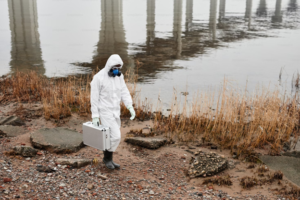
It would not help your imagination if you suddenly see something wiggling or floating in your supposedly clean tap water. That is why it’s best to know if your water is contaminated, if not outright dirty.
It’s not only about your health–it’s also about overall environmental sustainability. Take, for example, these causes of water contamination. Maybe it’s high time you find out how they pollute and if it’s still healthy for you.
Some Common Water Contaminants
Industrial Pollution
As technologies are discovered, more industries have grown like mushrooms around you. Some aspects, like giving a job or business to everyone in your community can be positive enough. But as these industries operate and throw away their trash and stuff, especially chemicals, that can be a worrisome and alarming subject.
It could be like what happened to the much-highlighted Camp Lejeune Contaminated Water Scandal that started around the 1950s to 1980s. It’s how some service members and their families were exposed to contaminated drinking water from the leaks and spills at the base’s industrial waste sites.
You may find it helpful to be in the know about Camp Lejeune lawsuit updates and articles to give you a more comprehensive idea of how dangerous contaminated water is. It can also help you avoid the risks and life-long damage it could do to you and your family.
Agricultural Runoff
You may consider agricultural runoff to have many threats to water quality, not only to your drinking water but also to those which you give to your pets and shower your plants with. Runoff from nearby agricultural activities poses many dangers as they are known to carry pesticides, fertilizers, and animal waste leaching into water sources.
It’s like when pesticides like atrazine and glyphosate have been detected in many waterways, impacting aquatic ecosystems and human health. Accordingly, these agricultural runoff have been some of the leading causes of impaired water quality in rivers and streams, affecting over 173,000 miles of waterways in the United States.
To address these issues, laws such as the Clean Water Act and many state regulations set limits on their pollutant discharges, especially from waterfront communities. It’s to promote the protection and restoration of waterways and improve water quality all over the world.
Sewage and Wastewater
Have you ever wondered where all your drain water goes? How much more sewage and wastewater from manufacturing plants and industries? See those horribly singing insects on a building’s water discharge? It might give you some idea of how untreated sewage and wastewater significantly risk water quality and public health.
These untreated sewage discharged into waterways can contain harmful bacteria such as E.coli and pathogens like Giardia and Cryptosporidium. It’s why the government said millions of gallons of untreated sewage are released into U.S. waters each year, contributing to water borne illnesses and ecosystem degradation.
In urban areas, those combined sewer overflows during heavy rain can overwhelm sewage treatment systems, causing breakouts everywhere. These situations often lead to direct releases of untreated wastewater into rivers and streams, increasing water contamination issues.
Also, aging, faulty, or inadequate wastewater infrastructure can contribute to sewage leaks and overflows, further compromising water quality. That is why governments worldwide focus on proper sewage treatment and infrastructure maintenance needs to safeguard water supplies and protect public health.
Determine if Your Water is Safe
If, in one way or another, you have these tingling doubts about whether your water is safe or not, it’s always best to be proactive than leave and ignore them. Your suspicions might have grounds for all you know.
Here are some tests you can do at home to see if the water you’re using or about to use is really safe.
- Regular Testing
Always watch out for changes in your water’s taste, odor, or appearance. Maybe it’s time to verify if it’s safe to use. You can buy DIY water testing kits so you can check water quality regularly, whether or not they have bacteria, heavy metals, or chemicals.
Still, if you’re not satisfied, you can hire professionals to do comprehensive testing for your peace of mind.
- Check for Advisories
It’s always an advantage to stay informed about any water advisories or alerts issued by your local authorities. Getting the news about potential risks or contaminants in your area’s water supply is a top priority for your and your family’s health.
- Install a Filtration System
Nothing grand, but just consider installing a water filtration system that’s certified to remove specific contaminants. You can research different filtration options to find one that meets your needs and budget and will be effective in keeping your water safer.






